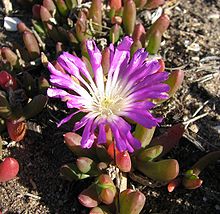- Disphyma
-
Disphyma 
Disphyma crassifolium subsp. clavellatum Scientific classification Kingdom: Plantae (unranked): Angiosperms (unranked): Eudicots (unranked): Core eudicots Order: Caryophyllales Family: Aizoaceae Genus: Disphyma
N.E.Br.Species: D. crassifolium Binomial name Disphyma crassifolium
(L.) L.BolusSubspecies South Africa, Australia and New Zealand. Its sole species, Disphyma crassifolium, is divided into two subspecies, edit] Description
It grows as a prostrate, succulent shrub or annual herb, from two to 30 centimetres high. Unlike the other pigfaces, its leaves are round in cross-section. Flowers are pink, purple or violet.[1][2]
Taxonomy
Disphyma crassifolium was first published as Mesembryanthemum crassifolium by Carl Linnaeus in 1753, based on South African specimen material.[3] In 1786, Georg Forster published M. australe based on New Zealand material. Forster failed to give a description, however, so valid publication of the name falls to William Aiton, who published a description in 1789.[4] In 1803, Adrian Hardy Haworth published M. clavellatum based on plants raised at Kew from seeds collected in Australia.[5] Thus distinct species were erected for each country in which the plant occurred.
The genus Disphyma was published by N. E. Brown in 1925. The type species for the genus was M. crassifolium, which would be transferred into Disphyma as D. crassifolium.[6] Apparently Brown neglected to formally transfer the species over, however, as this was done in 1927 by Harriet Margaret Louisa Bolus.[7] Three years later, Brown transferred M. australe into Disphyma as D. australe.[8] Robert James Chinnock published a new species name, D. blackii in 1971,[9] and five years later he transferred M. clavellatum to Disphyma.[10]
In the early 1980s, Hugh Francis Glen determined, on the basic of a multivariate analysis, that Disphyma was monotypic. All other names were therefore given synonymy with D. crassifolium.[11] This situation remained until 1986, when it was decided that the South African populations differed sufficiently from the Australian and New Zealand populations to merit distinct subspecies. D. crassifolium subsp. clavellatum was then erected to encompass the Australian and New Zealand populations,[12] with the autonym D. crassifolium subsp. crassifolium defined as encompassing the South African plants.[13]
Distribution and habitat
Disphyma is widely distributed in South Africa, Australia and New Zealand. It grows in saline areas such as coastal dunes and samphire flats, and tolerates a range of soils including sand, loam and clay.[1][2]
References
- ^ a b "Disphyma". FloraBase. Department of Environment and Conservation, Government of Western Australia. http://florabase.dec.wa.gov.au/browse/profile/22394.
- ^ a b "Disphyma crassifolium (L.) L.Bolus". FloraBase. Department of Environment and Conservation, Government of Western Australia. http://florabase.dec.wa.gov.au/browse/profile/2799.
- ^ "Mesembryanthemum crassifolium L.". Australian Plant Name Index (APNI), IBIS database. Centre for Plant Biodiversity Research, Australian Government. http://www.anbg.gov.au/cgi-bin/apni?taxon_id=263173.
- ^ "Mesembryanthemum australe Aiton". Australian Plant Name Index (APNI), IBIS database. Centre for Plant Biodiversity Research, Australian Government. http://www.anbg.gov.au/cgi-bin/apni?taxon_id=41561.
- ^ "Mesembryanthemum clavellatum Haw.". Australian Plant Name Index (APNI), IBIS database. Centre for Plant Biodiversity Research, Australian Government. http://www.anbg.gov.au/cgi-bin/apni?taxon_id=41652.
- ^ "Disphyma N.E.Br.". Australian Plant Name Index (APNI), IBIS database. Centre for Plant Biodiversity Research, Australian Government. http://www.anbg.gov.au/cgi-bin/apni?taxon_id=20831.
- ^ "Disphyma crassifolium (L.) L.Bolus". Australian Plant Name Index (APNI), IBIS database. Centre for Plant Biodiversity Research, Australian Government. http://www.anbg.gov.au/cgi-bin/apni?taxon_id=36361.
- ^ "Disphyma australe (Aiton) N.E.Br.". Australian Plant Name Index (APNI), IBIS database. Centre for Plant Biodiversity Research, Australian Government. http://www.anbg.gov.au/cgi-bin/apni?taxon_id=20846.
- ^ "Disphyma blackii Chinnock". Australian Plant Name Index (APNI), IBIS database. Centre for Plant Biodiversity Research, Australian Government. http://www.anbg.gov.au/cgi-bin/apni?taxon_id=20862.
- ^ "Disphyma clavellatum (Haw.) Chinnock". Australian Plant Name Index (APNI), IBIS database. Centre for Plant Biodiversity Research, Australian Government. http://www.anbg.gov.au/cgi-bin/apni?taxon_id=36347.
- ^ Prescott, A. and Venning, J. (1984). "Aizoaceae". Flora of Australia, Volume 4: Phytolaccaceae to Chenopodiaceae. Canberra: Australian Government Publishing Service.
- ^ "Disphyma crassifolium subsp. clavellatum (Haw.) Chinnock". Australian Plant Name Index (APNI), IBIS database. Centre for Plant Biodiversity Research, Australian Government. http://www.anbg.gov.au/cgi-bin/apni?taxon_id=36385.
- ^ "Disphyma crassifolium subsp. crassifolium (Haw.) Chinnock". Australian Plant Name Index (APNI), IBIS database. Centre for Plant Biodiversity Research, Australian Government. http://www.anbg.gov.au/cgi-bin/apni?taxon_id=63039. [sic]
Categories:- Aizoaceae
- Monotypic plant genera
Wikimedia Foundation. 2010.
Look at other dictionaries:
Disphyma — Saltar a navegación, búsqueda ? Disphyma Clasificación científica … Wikipedia Español
Disphyma — Disphyma … Wikipédia en Français
Disphyma — ID 27797 Symbol Key DISPH2 Common Name N/A Family Aizoaceae Category Dicot Division Magnoliophyta US Nativity N/A US/NA Plant Yes State Distribution N/A Growth Habit N/A … USDA Plant Characteristics
Disphyma crassifolium subsp. clavellatum — Scientific classification Kingdom: Plantae … Wikipedia
Disphyma crassifolium — ID 27798 Symbol Key DICR8 Common Name N/A Family Aizoaceae Category Dicot Division Magnoliophyta US Nativity Cultivated, or not in the U.S. US/NA Plant Yes State Distribution N/A Growth Habit N/A … USDA Plant Characteristics
Disphyma N.E. Br. — Symbol DISPH2 Botanical Family Aizoaceae … Scientific plant list
Disphyma crassifolium (L.) L. Bolus [excluded] — Symbol DICR8 Botanical Family Aizoaceae … Scientific plant list
Disphyma crassifolium (L.) L. Bolus [excluded] — Symbol DICR8 Botanical Family Aizoaceae … Scientific plant list
Aizoaceae — Aizoaceae … Wikipédia en Français
Aizoaceae — Mittagsblumengewächse Pleiospilos spec., Habitus und Blüte. Systematik Abteilung … Deutsch Wikipedia
